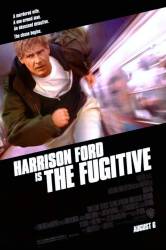Continuity mistake: Kimble arrives at a hospital to shave himself. He opens a drawer and places medicines on top of it. The amount and type changes between one frame and another.
Other mistake: When Kimble is heading towards the dam driving the ambulance in the tunnel, his lane is empty in the wide angles, yet in the close-ups he is swerving the steering wheel violently as if there were cars ahead. This keeps changing back and forth.
Character mistake: After Kimble jumps from the drain pipe over the waterfalls, the scene goes to Gerard standing in the pipe telling his crew to leave, then they all leave without picking up Gerard's gun that Kimble threw down next to him.
Continuity mistake: After the bus crashes, Kimble unlocks his hands and throws the keys onto the floor in front of Copeland. Two shots later the keys are lying in a different position when Copeland grabs them off the floor.
Factual error: Kimball's jump from the top of the dam spillway would not be survivable. Hitting the water from that height would be like hitting concrete and would basically tear the body apart.
Revealing mistake: When the movie begins and Kimble is questioned by the cops, the blood on his T-shirt remains red, instead of dark red or brown due to oxidation.
Visible crew/equipment: During the parade, Gerard motions for the other guy on his team to stay to the right. There are a couple of shots of the parade, followed by the one where Gerard looks over the green wall. As this is happening, the camera is moving to the left. Look in the windows of the building. You can briefly see it pass.
Continuity mistake: When the landlord's son is arrested, it's snowing, and the following scene is during the St. Patrick's Day parade, with no snow on the ground. The only other time there was snow was when the other fugitive was arrested/killed, so they must have filmed that the same time of the year.
Continuity mistake: The prisoner starts foaming at the mouth and pulls the sharp implement from his sock, but when he is shot, he collapses back in his seat with no sign of the foam around his mouth.
Continuity mistake: Kimble puts the worker's uniform on over his prison uniform, but when he takes it off to tend to his wounds, we only see him remove the worker's uniform, with no sign of the prison uniform.
Other mistake: During the St. Patrick's Day parade, the camera shows a clock that displays the temperature, which is supposedly 23°. None of the spectators or performers we see is dressed for that temperature. They would be way more bundled up than they are. Everybody is dressed for weather in the 40s or so.
Continuity mistake: When the Marshals go to arrest Copeland, they are in Whiting, IN. When the Sheriff's car comes through, it is an Illinois State Police car.
Visible crew/equipment: The camera filming the wide shot of the press conference with the US Marshals and Chicago PD blends in with the rest of the camera crews there doing the conference. It is blatantly visible behind everyone asking questions. The angle from this camera is used at least twice. You can identify it by its film magazine. Almost all news organizations in the 1990s used video tape as opposed to film, so a film camera used during a press conference would and does stick out like a sore thumb.
Character mistake: The investigators say that the prints found in Sykes' apartment belong to Kimble after dusting for them, making it clear they didn't use any equipment for fingerprint analysis or testing. No forensic investigator would confirm who the prints belong to until they run a thorough analysis. It seems as if they were basing the fact that they belonged to Kimble because they traced the call to the apartment, rather than acknowledge that the prints could belong to someone else.
Continuity mistake: When Kimble leaves the hospital and the detectives arrive, it's dark outside. However, when they're interviewing the nurse, you can see it's daylight outside.
Factual error: In the train crash scene there are many mistakes. 2 locos are pulling a hand full of cars, a small switcher loco would actually have been used. Oil journal bearings that haven't been used for decades. A flat car carrying logs, but there is no logging in the Chicagoland area. The second loco for some reason derails. In reality the train would have just pushed the bus a few hundred feet with no derailment. The shed explodes. The 200 ton loco just slides along the soft ground.






Suggested correction: 20s is nice and toasty.